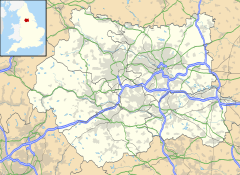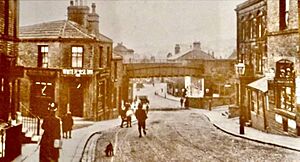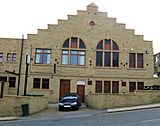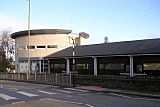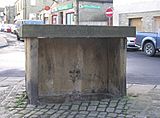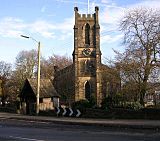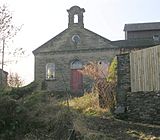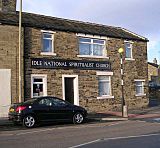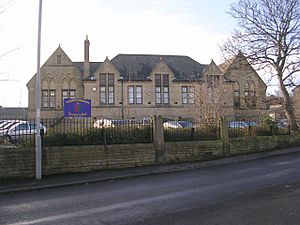Idle, West Yorkshire facts for kids
Quick facts for kids Idle |
|
|---|---|
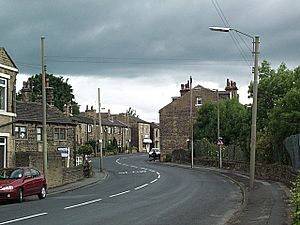 Highfield Road, Idle |
|
| OS grid reference | SE178383 |
| Metropolitan borough | |
| Metropolitan county | |
| Region | |
| Country | England |
| Sovereign state | United Kingdom |
| Post town | BRADFORD |
| Postcode district | BD10 |
| Dialling code | 01274 |
| Police | West Yorkshire |
| Fire | West Yorkshire |
| Ambulance | Yorkshire |
| EU Parliament | Yorkshire and the Humber |
Idle is a friendly suburban area in Bradford, West Yorkshire, England. It used to be a separate village, and even before that, it was known as the Manor of Idle. It's located in the north-east of Bradford, surrounded by areas like Eccleshill, Wrose, Thackley, Apperley Bridge, and Greengates.
Idle is about 5 miles (8 km) north of Bradford city centre. The River Aire and the Leeds-Liverpool Canal form its northern border. In 2021, the area of Idle and Thackley had a population of 17,290 people.
The name "Idle" comes from an Old English word, "Idel," meaning "Empty Space." There's a story that it comes from "Idlawe" or "Ide's Hill," named after an Anglo-Saxon settler called "Ide." However, most historians don't believe this story because there isn't enough proof.
Today, many people living in Idle work in retail, healthcare, and education. In the 1800s, Idle grew a lot because of the Industrial Revolution. Like much of Bradford, it was known for its textile industry. You can still see old mills in the village today. Idle also had a successful quarrying industry, digging stone from Idle Moor.
Contents
Discovering Idle's Past
Evidence shows that people lived in Idle as far back as prehistoric and Roman times. Roman coins were found by quarry workers in the 1800s at Catstones Quarry on Idle Moor. Other old items, like brooches and coins from the 1st and 2nd centuries, were also found there.
Prehistoric flints found near the River Aire suggest even earlier human activity. This means people were likely in the Idle area a very long time ago.
The first written record of people settling in Idle is from the 1100s. A local landowner, Nigel de Plumpton, gave land to nuns in Esholt. This land was called "Idel," meaning "Empty Space." The Plumpton family were the first landowners of the area, known as the Manor of Idle. By the 1400s, their wealth decreased, and the manor was divided among new owners.
The Manor of Idle included the villages of Idle and Windhill. It also had smaller settlements like Thackley, Thorpe-Green, Parkhill, Cross-Keys, Buckmill, and Wrose. The Manor was bordered by the River Aire to the north and Pighill Beck (now Haigh Beck) to the east.
Idle's Industrial Growth
During the 1800s, Idle, like the rest of Bradford, was famous for its textile industry. But Idle also had a big quarrying industry. Stone from Idle was sent all over England and even to places like China, Australia, and South America.
In 1893, a survey showed that mills like Castle Mills, Union Mill, and New Mills employed about 1,100 people. Because of this industrial success, Idle's population grew rapidly. It went from 3,400 people in 1801 to over 12,000 by 1871.
Churches Through Time
Idle was once part of the Calverley parish. In 1584, a small church, called a "chapel of ease," was built on Town Lane. It was rebuilt in 1630 and is now known as Old Chapel. A school was added to Old Chapel and later rebuilt as Round Steps School in 1836. This school building also had a lockup and town offices. It was torn down in the late 1800s. In 1914, there was a plan to demolish Old Chapel to widen the road, but people successfully saved it.
Other churches were built over the years. Upper Chapel was built in 1717 and rebuilt several times, becoming the United Reformed Church in 1972. The Primitive Methodist Church opened in 1861. Thorpe Methodist Chapel was built in 1814. Holy Trinity Church was built in 1830. The Unitarian Church and St John's Church were also built but later demolished. The Idle Baptist Chapel opened in 1810, and the Idle Baptist Church in 1875, which was demolished in 1983.
The Salvation Army came to Idle in 1884. Their current worship hall, the Idle Citadel, opened in 1893 on Walter Street. In 1999, a new community hall was added. The Idle Spiritualist Church is on Highfield Road.
Transport and Industry
Idle's early industries included coal mining and quarrying. Stone was transported using the canal and later by railway. Mills in the area included Old Green Mill, Union Mills, and Albion Mill.
Idle had two railway stations at different times. The first was Idle (L&BR) station, open from 1847-1848. The second, Idle railway station, operated from 1875 to 1968. The railway helped move goods and people. Today, you can still find parts of the old railway tracks, though nature has reclaimed them.
Watmough's printers, a local business, was founded in 1888. Their buildings on High Street were later demolished for housing. A tram service ran from Bradford to Thorpe Garth from 1901 to 1931, followed by a trolley bus service.
Jowett Cars Ltd had a car factory in Idle until 1954. Then, International Harvester made tractors there until the early 1980s. The factory was demolished, and now the site is a retail complex called Enterprise 5, with stores like McDonald's and Morrisons.
The Idle Picture Palace, a cinema, opened in 1912. It later became a Bingo hall and was demolished in the early 1970s. More recently, a Hillards Supermarket, which became Dunnes Stores, was replaced by Home Bargains and Aldi.
Idle's Geography
Idle doesn't have clear borders with its neighboring areas. However, there are three main parts to the village. Thorpe Edge, to the south-east, is mainly a working-class area. The central part, around Highfield Road and Town Lane, is a middle-class area. Another middle-class area is to the east, along Leeds Road.
To the far west, bordering Wrose, is the mostly rural Idle Moor. This hilly area offers great views over the River Aire valley towards Shipley and Baildon.
The village centre has a small village green with shops, banks, pubs, and eateries. Near Leeds Road, there's a recreational area called the Idle Rec. It has football fields, tennis courts, a bowling green, and a children's play area. Idle and The Green are also protected as a conservation area.
Local Government
Idle was once a small part of the Calverley parish. In 1866, it became its own civil parish. Briefly, in 1894, it was an urban district. But in 1899, it became part of Bradford when Bradford became a city.
Today, Idle is in the ward of Idle and Thackley. It's also part of the Bradford East parliamentary constituency. This new constituency was created in 2010.
Idle doesn't have an official twin town. However, Shipley, a nearby town, had connections with Hamm in Germany during the 1970s and 1980s. Representatives from Hamm visited Idle and other parts of Bradford.
Important Landmarks
Idle's High Street, leading from Highfield Road, is home to businesses, pubs, a medical centre, and a dental practice.
On High Street, you'll find the 'Idle Working Men's Club', built in 1928. Its name often makes people outside the village smile. It sounds like a club for "lazy" working men, but it's just a working men's club in the village of Idle! This unique name has made the club famous worldwide. Many people want an "Idle Working Men's Pass." The club has over 1,000 members, which is a lot, especially since many similar clubs in northern England have closed. Women were allowed to become members in 1995.
Idle has more than a dozen pubs and bars. The Post Office is on Bradford Road. The West Yorkshire Police's Eccleshill Police Station is also in Idle. On Leeds Road, you can find the Bradford branch of the British Red Cross.
Idle's War Memorial is at Holy Trinity Church on Town Lane. It remembers the 215 men from Idle who died in both World Wars. Many houses and buildings in Idle are very old, some almost a century old. They show how Bradford grew during the Industrial Revolution.
Under the western part of Idle runs a sewage tunnel from Frizinghall to Esholt. One of its ventilation shafts is near the Hepworth and Idle Cricket Club's field. A TV repeater transmitter is also located near Idle Hill.
Churches in Idle
Holy Trinity Parish Church, a large Victorian church from 1830, is on Town Lane. It has a graveyard and a bell tower. Idle Upper Chapel is on Westfield Lane, and Idle Baptist Church is on Bradford Road.
Education in Idle
On Leeds Road, you'll find Immanuel CE Community College. Idle C.E. Primary School is on Boothroyd Drive. Thorpe Primary School is on Albion Road. The Stage 84 Performing Arts School is on Town Lane. Blakehill Primary School is on Highfield Road. Idle also has a branch library on Albion Road.
Sports and Activities
Idle has several cricket pitches and teams, including Hepworth & Idle CC. The village also has a football team with different age groups, like under 14s.
Two local rowers, Chris Nicholl and James Tordoff, from Team “Hell Oar High Water,” completed the 2019 Talisker Whisky Atlantic Challenge. They rowed across the Atlantic Ocean in just over 44 days!
Culture and Events
Local musical groups include the Idle and Thackley Operatic Society and the Idle Bell Ringers. The Idle Beer Festival is held at the Hepworth and Idle Cricket Club.
The Idle Working Men's Club (often called "Idle W.M.C") is famous for its funny name. It opened in 1928 for sewage workers who couldn't drink at local pubs after late shifts. Famous honorary members have included Mohammad Al Fayed, Paul Gascoigne, and Michael Jackson.
Idle is also home to the Stage 84 School of Performing Arts and the ND Dance academy. Stage 84, founded in 1984, has put on shows at the Edinburgh Festival Fringe, St. George's Hall, and the Alhambra Theatre. The school helps students get qualifications from LAMDA, Trinity College London, and IDTA. Many famous performers, like Jack P. Shepherd, Kimberley Walsh, and Nikki Patel, trained here.
Famous People from Idle
Many notable people have connections to Idle:
- Joseph Whitworth (1803–1887), a famous engineer and entrepreneur, studied in Idle.
- Sir Robert Jennings (1913–2004), a former President of the International Court of Justice, was born and grew up in Idle.
- English actor Michael Rennie (1909–1971), known for playing Klaatu in The Day the Earth Stood Still, was born in Idle.
- Vic Feather (1908), a well-known trade union leader, was also born in Idle.
- Adrian Edmondson, a comic actor and writer, grew up in Idle.
- Hannah Midgley, a former actress from the TV show Emmerdale, has lived in Idle for most of her life.
- Dickie Watmough, a footballer for teams like Bradford City and Blackpool, was born in Idle.
- Yorkshire and England cricketer Doug Padgett was born in Idle and played for Idle Cricket Club.


